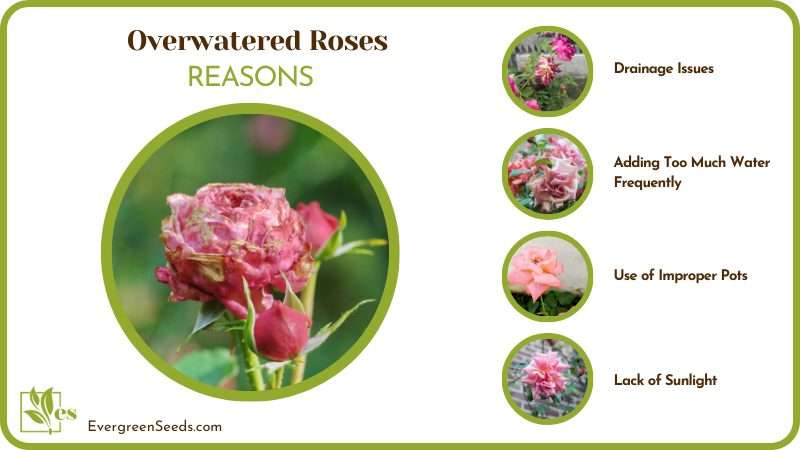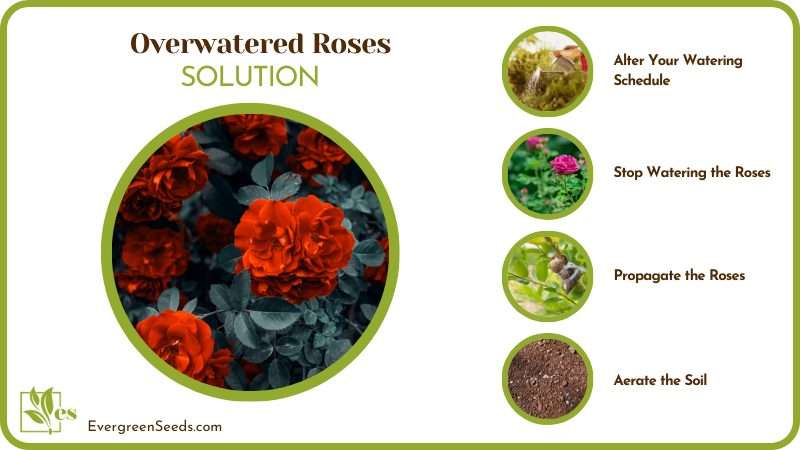Overwatered roses may fail to absorb oxygen, nutrients, and water, and this may result in health problems. The roses’ yellow leaves, some of which may be wilting and drooping can be signs of overwatering.

You should know that underwatering can cause wilting too but the roses will have dry, brittle leaves while the overwatered ones have too soft foliage. Read on to know more about the rose problems and solutions so that you can restore your plant to its vibrant look.
What Causes My Roses to Become Overwatered?
Your roses may be overwatered because of poorly draining potting mixes, too much water during watering, environmental conditions, and lack of sunlight. You will learn more about how your growing roses can be affected by too much moisture in the potting mix.
– Drainage Issues
The roses prefer well-draining potting mixes that contain organic matter, peat moss, and sand. If you use water-holding soils like clay, excess moisture will be contained in them for a long time. This will result in waterlogging conditions and the foliage will start turning yellow. The roses, just like the overwatered marigold can then develop root rot and black spot. Many parts of the rose will be affected due to overwatering.
The soil substrates can also block the drainage holes due to repeated watering. At the end of the day, water becomes collected in the pot, thereby causing overwatering. You should always check the drainage holes to see if they are open. Do not relax just because you are using well-draining potting soil and a pot with holes.
Your roses can still suffer overwatering if the holes are not performing well. So, when watering roses, make sure you check to see if the water drains out so that any discrepancies can be noticed quickly.
– Adding Too Much Water Frequently
Water is essential for your roses to grow healthy and bloom but can be harmful if not provided in the correct amounts and at appropriate times.
The roses should be watered thoroughly at a time but make sure you give them enough time to dry out before another watering. The established roses need two gallons of water at every watering session and they should be irrigated once per week.
If you add more water than required, this may lead to overwatering. You should also add four gallons of water once per week also to a large, climbing rose. New plants need two gallons as well but they should be watered three to four times a week. This is because new roses need to establish their roots and develop some leaves so, they should be kept moist.
The potted rose should also be irrigated at most two times. If you do not follow all these requirements, your roses can be overwatered.

– Changes in Environmental Conditions
You should keep an eye on the environmental conditions around your plant to ensure that they are less supportive of overwatering. The roses are dormant in winter so they can be overwatered if you water them too often.
You can water roses once every two weeks during this season and increase the frequency in summer. So, if you continue giving the plant more water when it needs less, the chances of overwatering are high.
Also, monitor the weather conditions closely to avoid overwatering problems. Please note that the roses may also need more water when the weather is windy. The potting mix dries faster under such conditions and even more if they are accompanied by high temperatures. Cooler temperatures with no wind tend to reduce the rate of evaporation.
– Use of Improper Pots
You should not use pots without drainage holes. Usually, decorating pots do not have holes to allow excess water to escape, and using such containers will cause the roses to become overwatered.
So, if you want to use these pots, plant your rose bush in a pot with drainage holes and then put it in a decorating container. The decorating vase should be large enough to accommodate the pot with the plant.
You can also create holes by drilling the pot using the correct tools. Make sure the size of each hole is small enough to stop the potting mix from coming out. They should allow only water to flow out.
Plastic pots are also discouraged because they hold moisture for a long time. If you continue following the normal watering patterns, your roses can be overwatered. You should reduce watering when using plastic pots to reduce the risk of overwatering. Too big pots can also cause overwatering as they do not dry faster. You can also remove the rose bush to transplant it to a better place or pot.
– Lack of Sunlight
The roses thrive well in full sun. The evaporation is also faster if the potting mix is exposed to sunlight. Therefore, if you keep your roses in a low-light area or place with no light, you will be risking your plants to overwatering. The soil remains wet for an extended period so, it is more likely to become soggy.
How to Fix the Problem of Overwatered Roses
Drooping rose buds and leaves turning yellow are some of the signs of overwatering. Once you notice them, you should immediately take action. In this section, we explore some of the measures that you can follow to rectify the problem.
– Alter Your Watering Schedule
Always allow the potting mix to dry first. You can check if the growth medium is completely dry by poking it with a chopstick through the drainage holes of the pot. If the whole potting mix is dry, then it’s the right time to resume watering.
After watering, wait until you see that the roses are drooping and water again. Record the date and repeat the process once more. By doing this, you are creating a new pattern of watering to avoid overwatering. When your roses show some signs of drooping, it means the plant is now thirsty so you can give it another drink.

Please note that overwatering and underwatering roses can both cause drooping. The knockout roses drooping is also because of too much or less water.
– Stop Watering the Roses
When the rose is overwatered, the pH levels become too high due to the shortage of oxygen. The iron becomes scarce as well, thereby causing the rose leaves to turn yellow. Later on, the rose leaves turning yellow may become droopy. So, once you notice these signs, stop watering your roses.
Wait for the potting mix to dry before watering again. In the process of drying the potting mix, do not expose your roses to too much sunlight. Place your plant in a low-light spot so that you can protect the dying leaves from the sun’s heat. The rose can then recover from wilting.
Start watering the roses again when you are satisfied that the soil is dry. Make sure you follow the correct watering schedules depending on the weather, type of soil, and size of the roses.
Once you resume watering, make sure the rose is getting enough sunlight as it requires six to eight hours of continuous exposure. You should protect your plant from the afternoon sun as it can scorch the rose plant.
– Repotting
If you suspect that the overwatered roses are now suffering from root rot, we recommend that you repot them. Gently uproot the plant and wash it so that you can see the rotten roots. Trim the affected roots and apply fungicides to destroy the fungi that cause root rot. Allow your roses to dry before placing them in a new pot
Plant your roses in a pot with fresh, well-draining potting mix. Make sure you prune all the dead leaves. Then, water your rose thoroughly prior to placing it on a spot that is warm, with indirect sunlight, until it is established. Keep the rose moist as a way of dealing with transplant shock.
– Propagate the Roses
Like the over-watered azalea, the heavily affected roses can be propagated to get a new healthy plant.
Root rot is dangerous and the infected rose can die. So, if you discover that your overwatered roses cannot be saved, try to get a healthy cutting. Choose a stem with withered flowers and dropping petals but remember to remove them.
The cutting should be four to eight inches long, with at most five nodes. Place your cutting into the potting mix and water it thoroughly.
Remember to avoid direct sunlight and put the humidity cover to keep your cutting moist but make sure you open it regularly to aerate the plant. Expect to see the roots developing within a month or two and only then can you remove the humidity cover.
You can transplant the new roses when they have grown some leaves. Begin watering the roses the recommended way when they are established in their new pots. Overwatering is not good for all plants so, make sure you follow all the care requirements properly.
Remember, there is no straightforward answer to the question, “How much water do roses need?” as the amount depends on factors such as the size of the plant and environmental conditions.
– Aerate the Soil
You can poke the substrate to create air pockets as a way of improving aeration. This can help the soil to dry as quickly as possible. Naturally, air pores are created by worms and bugs that live in the soil. So, if your plant is potted, there are high chances of not having those microorganisms, which is why you need to do it yourself.
– Add a Layer of Gravel
If your container does not have drainage holes but the overwatered rose is still healthy, add a layer of gravel. It should be at the base of your pot.
The gravel has large particles that allow water to pass through. So, excess water that is drained is collected at the bottom of the pot. The water will be absorbed later when there is no moisture in the potting mix.
You should water roses the moment you see that they appear to be drooping. This is a clear sign that there is no moisture in the potting mix. A layer of gravel should be covered with a fine mesh wire so that the potting soil may remain on top of the gravel, where it will be separated from the drained water.
References
- Shelby Simon, Lowe Saddler. (Sep 26, 2022). 21 Gardening Fail Stories That Will Teach You What Not To Do. Forbes Home.
Retrieved from https://www.forbes.com/home-improvement/features/gardening-fail-stories/ - Larry A. Sagers. Roses for Utah Landscapes. USU Extension.
Retrieved from https://digitalcommons.usu.edu/cgi/viewcontent.cgi?article=2347&context=extension_histall - Desert Rose. University of Florida.
Retrieved from https://gardeningsolutions.ifas.ufl.edu/plants/ornamentals/desert-rose.html - Jennifer Olson. (Feb. 2017). Diseases of Roses. Oklahoma State University.
Retrieved from https://extension.okstate.edu/fact-sheets/diseases-of-roses.html - Mark Bennett. How Best to Water Roses (7 Useful Tips). Gardener report.com
Retrieved from https://www.gardenerreport.com/watering-roses/












